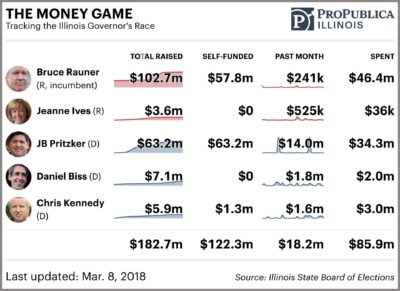Look closely at these two versions of “The Money Game,” our widget to chart contributions to candidates in the Illinois governor’s race. The two versions — one the original, the second updated to include data from two years earlier — tell different stories:
Original:

Updated:

In the first, which looks at fundraising dating to Jan. 1, 2017, Gov. Bruce Rauner shows no self-funding. That’s correct: The Republican incumbent didn’t donate any money to his campaign in 2017 or the first two months of 2018.
In the second, which dates to Jan. 1, 2015, we get a more comprehensive view of Rauner’s contributions across the board. It shows he gave his campaign fund, Citizens for Rauner, $50 million on Dec. 20, 2016.
If you just look at the first version, Rauner isn’t self-funded.
If you look at the second, he is.
Our decision to update the widget to include data from earlier years points to another bit of tricky business: the definition of a campaign. In many cases, candidates and their supporters create political action committees, or PACs, that span election cycles and engage in activities that don't fit the traditional functions of a campaign. PACs frequently transfer money to other PACs to support other candidates or causes.
Citizens for Rauner is focused on the governor’s re-election, but it also pours money into the campaigns of candidates for other offices. For a time, some of his campaign aides ran a separate PAC that supported or opposed other state legislative candidates.
In the end, we decided to track everything coming into and going out of the candidates’ own campaign funds, but not PACs run by supporters or allies. The best we can do is be transparent about how we’re choosing to present numbers. There will always be tradeoffs.
Filed under:


